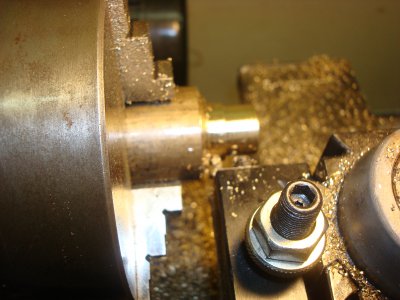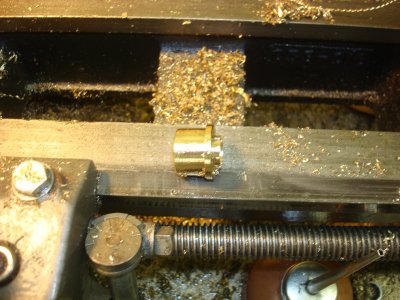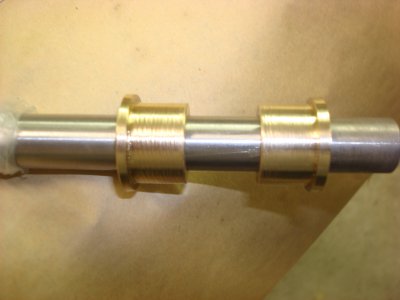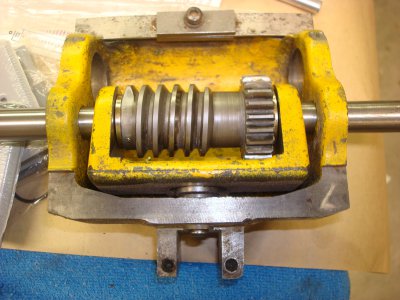Made a few parts where the store price was less then the material cost, I did it to get my cost per part lower. Wife figures equipment cost divided by number of pieces probably got me down to 50 bucks per piece plus material and labor. I recommended to her that there should be a credit for me not bugging her against that. Now remember I'm not an accountant and am using fuzzy bookkeeping as my guide but the benefit to her should be priceless! Its not the cost its the fun of doing it. Its a hobby.
-
Welcome back Guest! Did you know you can mentor other members here at H-M? If not, please check out our Relaunch of Hobby Machinist Mentoring Program!
You are using an out of date browser. It may not display this or other websites correctly.
You should upgrade or use an alternative browser.
You should upgrade or use an alternative browser.
My Bronze Flange Bushings
- Thread starter Kroll
- Start date
YAHOOOOOO!!!!!!This bushing project is finish,well for this part it is.Dang what a project,I was so afraid that I was going to turn the OD to small or the ID to big so I was taking small passes each time sneaking up on the finish size.Guys I have never made anything that actually had to fit something,OD and the ID.These bushing is for my Colchester lathe which makes this a project within a project,it was nerve wrecking but it was fun to do since It works perfectly and it don't wiggle around like to other.Thanks guys for the help-----kroll








- Joined
- Nov 12, 2015
- Messages
- 497
Welcome to the club. Keep fooling around, take a break when it ain't working and try to think it out. Figger your machine out, see if numbers repear. I tell my guys their finish chip is .010. Set zero's and see if your machine repeats. If it ain't working, ASK A QUESTION.
- Joined
- Jun 7, 2013
- Messages
- 10,089
Brass does not make a good bushing, at all; the person who posted this thread said that he used 660 bronze, which is a very good choice of material for a bushing that is going to be lubricated; if not lubed, Oilite is a good choice if lightly loaded situations. For heavy loads with lube, 954 (aluminum) bronze is a good choice, but needs to have heat treated shafts, or it is likely to score.The old bushing was probably an oil lite bushing, they are impregnated with oil and are dark in color.
Your new bush does look like brass, but pictures lie where color is concerned.
brass makes a fine bushing, put it and see how it goes. If it wears out early, make a new one. By that time you will be able to do it your sleep.
Reaming bushings instead of boring is not a good idea, as non concentricity is likely to result; it is possible to bore undersize for concentricity then ream for finish, but it is not possible to achieve optimum clearance in the finished bushing. Also it is said that reaming is not recommended for Oilite bushings, as it tends to smear shut the porosity so that the impregnated oil does not effectively flow to the bushing/shaft interface. A good choice in boring bars for the lathe for short bores are the type used in boring heads in milling machines, where the top is flat, the end is ground square and is sharpened only on the ends. My favorite boring bars are those made by the Bokum Tool Co. and are circular form relieved and are sharpened only on the top; they come in lead angle, square across the front, and threading styles. I have found many of them on E Bay, in addition to buying them from the manufacturer; they come in integral shank styles as well as threaded on shank, where you can make your own shanks in the larger sizes.
Ya just gotta keep at it. Issues with cutters is common, especially with inherited tooling. It's a trial and error type of thang.....as well as a healthy dose of patience. Congrats on figgering it out.
I have read that a few times here, now.
The bit about inherited tooling.
Most all of my tooling is inherited, and I see issues with cutters having been overheated. Dull, ground to nubs. Is this what you mean when you say that?
All the dial indicators, mics... stuff like that works. The mic is dead on. haven't used the inside or over 1" mics yet, so cant say much on that.
Could you maybe explain your statement some.... I need to know what I need to look out for....
My apologies... lil bit off subject... a question from one old fart to another.
- Joined
- Nov 12, 2015
- Messages
- 497
I've had guys say they have burned up cutters and soaked them in Coke to take the burn off the cutter before turning it back in to the tool crib. I've seen reamers with a burr on them, oversize holes. Incorrectly ground flutes on drills producing oversize holes or just sit there trying to burnish a hole in the material. Stuff like that.
With machines it's repeatability, bearings and gears bed ways, etc. Stuff that pops up when you first put power to it and make chips.
With measuring equipment it's easier, throw a jo block or a known size piece in your pocket and see how it measures.
With machines it's repeatability, bearings and gears bed ways, etc. Stuff that pops up when you first put power to it and make chips.
With measuring equipment it's easier, throw a jo block or a known size piece in your pocket and see how it measures.

